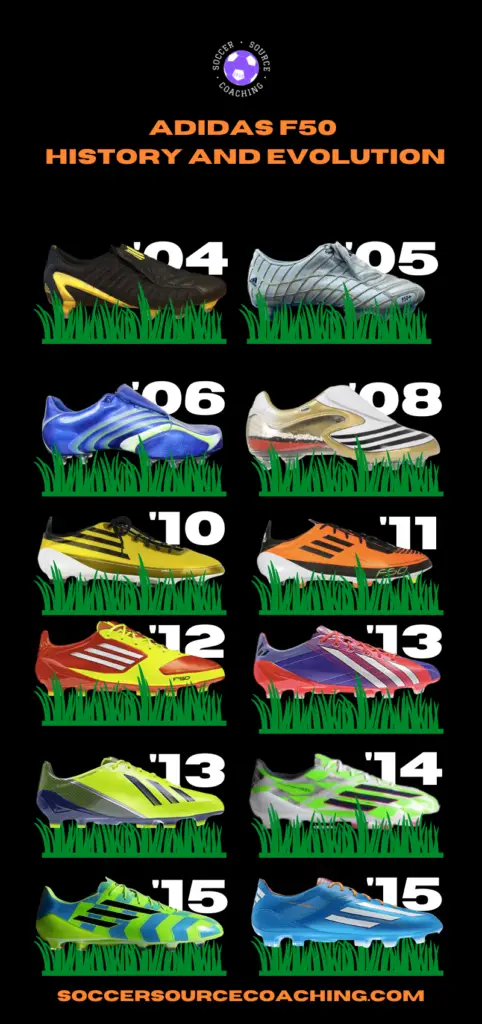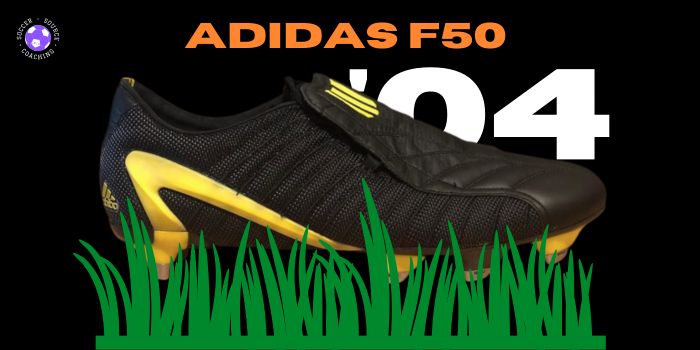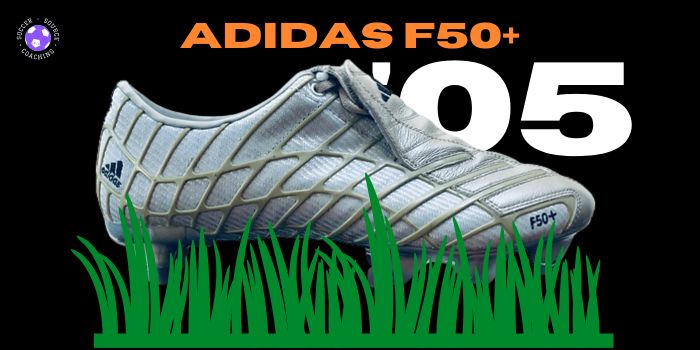Throughout the Adidas F50 history, Adidas has gone above and beyond to develop the lightest and most customizable boots on the market.
The Adidas F50 was a pioneer in the soccer boot industry for using innovative materials and manufacturing techniques.
The focus was to improve the speed and performance of the players wearing them, with the “F” in F50 standing for “Fast”.
In 2010 the Adidas F50 adiZero model weighed only 165 grams and helped players feel faster and more agile on the soccer pitch.
At the time this was one of the highest boots on the market.
Another reason why the Adidas F50 brand was so popular is because of the wide range of colors and personalization options.
The F50 miCoach also included a speed sensor that would track performance during games and training, opening up performance analysis to players at various levels.
Adidas F50 Soccer Cleats/Boots Timeline

Adidas F50 (2004)

In 2004 the Adidas F50s were launched just before Euro 2004 and were an immediate hit with soccer players from around the world.
This was because of their lightweight design, comfortable feel, and interchangeable studs.
F50s were revolutionary when compared to other soccer boots on the market during this time period.
The interchangeable studs allowed players to seamlessly adapt their boots to the conditions of the playing surface along with the lightweight materials and sock-like inner liner providing maximum comfort for the player.
The original F50 model paved the way for the next 11 years of success for this soccer cleat.
Adidas F50+ (2005)

The Adidas F50+ soccer cleats were an improved version of the original F50.
They had a detachable insole that allowed players to customize the fit to their liking.
The upper part of the cleats was made of synthetic material that was lightweight and durable, which helped players move quickly on the field.
The cleats were available in different colors, so players could choose the ones they liked best.
They also sported the iconic spider web design that caught the eye of players and fans.
Adidas F50.6 (2006)

2 years later in 2006, Adidas released their F50.6 model the included serval improvements to the already well-established F50+ model.
The first change came in the form of an alternative synthetic material called “Goleo calf leather”.
Which was a lighter weight than the original material used while making the boot more durable and resilient to water and tearing.
It also maintained a snug fit for the player.
Adidas also featured a new outsole for the F50.6s.
This was lighter and more flexible than the previous outsole used in the F50 model.
It allowed better traction on the pitch that helped increased a player’s speed and agility.
Another big change that was made was moving the lacing system from the middle of the boot to the off-center which relieved pressure from the foot and enhanced comfort for the player
[amazon_auto_links id=”10677″]
Adidas F50.8 (2008)

The Adidas F50.8 was released in 2008 and made with an improved Sprintskin synthetic.
This helped to decrease the weight while maintaining the same level of comfort and flexibility.
The F50.8 model also featured a new ” Traxion” outsole which grip and balance on the pitch.
On top of the new outsole, the stud configuration was adjusted to a new “speed stud” design which helped to evenly spread the weight of the player across the surface, relieving pressure off the foot.
This model also had better shock absorption and support for the foot.
Adidas F50 adiZero (2010)

The Adidas adiZero was launched in 2010 and was a major factor in propelling the F50 line further forward in the soccer cleat industry.
This was a pivot in the Adidas F50 history.
One of the biggest improvements Adidas made to this cleat design was its lightweight construction.
It became one of the lightest boots during this time period.
In this model, Adidas introduced a new cushioning system called the “SprintFrame”.
This increased stability and support without adding extra weight to the boot.
This model also included a “saddle” construction to help lock in the foot of the player and provide more stability.
The design of the aidZero was more streamlined and minimalistic to reduce drag which improves speed and agility.
Adidas F50 adizero Prime (2011)

The F50 adiZero Primes were released in 2011 and were an updated model of the F50 adiZero built with the purpose of being even lighter and faster.
The F50 adiZero Primes weighed a total of 145 grams per boot.
It was also the first soccer cleat that featured the 3D Dribbletex layer which provided better ball control for the player.
As well as focusing on performance Adidas also wanted to focus on the environmental impact too!
The Adidas F50 adiZero Primes were made from recycled polyester and were designed in such a way that they could be disassembled and recycled at the of their life cycle.
[amazon_auto_links id=”10677″]
Adidas F50 Second Generation miCoach (2011)

In 2011 Adidas launched its Second generation F50 adizero that featured its own miCoach technology.
This was a first of its kind in the Adidas F50 history
When this model is compared to the F50 adiZero it is very similar in design, performance, and structure.
The 2nd generation uses Sprint web technology that reduces the weight while providing stability and support.
These boots also include internal thermoplastic polyurethane (TPU) support bands.
They are essentially thin strips or bands that are strategically placed within the upper to provide support and structure.
However, unlike the F50 adiZero, the miCoach has a small chip in the sole of the boot that allows players to track their performance data during games and practices.
The chip would then transfer the data to a smartphone or computer so that players assess their performances.
These are some of the metrics players could get data from:
- Speed
- Distance covered
- Sprints
- Acceleration
- Deceleration
The Adidas F50 miCoachs’ was an innovative option that allowed players of all levels to exposure to their in games states to improve their overall performances.
Adidas F50 Messi (2013)

This was a special edition F50 soccer cleat that was based on the adiZero.
It was the first of its kind in the Adidas F50 history.
The Adidas F50 Messi was released in 2013 to honor Leonel Messi who is regarded as one of the greatest players of all time and arguably Adidas’ largest sponsor.
The soccer boot was tailored specifically for Messi’s playing style.
As well as adapting the soccer cleat for Messi’s playstyle Adidas style of the cleat was also centered around his birth country and his own personal logo.
The soccer cleat was made with a light and durable Hybridtouch synthetic material.
Unique to this soccer cleat was the MessiGambetrax outsole that provides superior grip and balance on the pitch, especially for sharp changes of direction.
It also featured the 3D Dribbletex texture that was used in the F50 adiZero Primes
Adidas F50 adizero 3rd Generation (2013)

In 2013 Adidas also released its 3rd generation of the F50 adiZeros’.
Similar to the 10-year anniversary boot it also boasts the Speedfoil material and Speedtraxion.
The stud configuration has been slightly adjusted to help improve grip and agility on the pitch while maintaining comfort.
This F50 model also came with greater color customizations and combinations for players to really express themselves.
[amazon_auto_links id=”10677″]
Adidas F50 10/10 (2014)

To celebrate the 10-year anniversary of the F50 line, Adidas released the Adidas F50 10/10 in 2014.
It took inspiration from the previous F50 models, including the F50 Adizeros’ and the F50 Messis’.
One of the most notable changes Adidas made to the F50 10/10 was the introduction of the new Speedtraxion outsole.
The purpose of this outsole was to provide even greater traction, which can help with acceleration and sharp changes of direction, particularly lateral movements.
The Speedtraxion sock liner would also provide added support and cushioning for the foot of the player.
Adidas also used a new material called Speedfoil in the upper part of the cleat, reducing the overall weight but increasing the durability and toughness.
The graphic design of the cleat also pays homage to F50s heritage.
Adidas F50 adizero Crazylight (2015)

In 2015 Adidas released their F50 adiZero Crazylight soccer cleat.
This was a limited-edition boot that would only weigh 135 grams, 10 grams lighter than the F50 adiZerp Primes.
This was achieved by using lighter materials and stripping away any extra weight from the design.
The bold colors of the design were perfect for players who really wanted to stand out.
Adidas F50 adizero 4th generation (2015)

The Adidas F50 adiZero 4th generation was released in 2015 and would be the last model continued in the Adidas F50 history line.
Adidas would go on to replace it with the X and Ace series.
The 4th generation was manufactured with the Speedfoil to maintain its lightweight feel and responsive ball control.
It also boasted an updated Sprintframe outsole with greater balance and grip on the surface.
They made this soccer cleat available for firm ground, and soft ground and included a leather version too.
This was the last variation of the F50 adiZero line before Adidas discontinued it in 2016.
[amazon_auto_links id=”10677″]
Adidas F50 Frequently Asked Questions
When did Adidas F50s come out?
The F50s were released in 2004.
The goal of this soccer cleat was to provide a lightweight and performance-enhancing boot for players ranging from the amateur leagues all the way through to the professional leagues.
When did Adidas stop making the F50?
Adidas discontinued the F50 in 2016.
Instead, Adidas with move onto the X and Ace series in their soccer boot line.
The last model created in the Adidas F50 line was the Adidas adiZero 4th generation.
Who wears Adidas F50s?
As the Adidas F50 line was discontinued in 2016 there are currently no professionals wearing Adidas F50s
There have been many notable professionals who have worn the boot in the Adidas F50 history.
Some famous soccer players include:
Evolution of other soccer cleat and boot models
I you enjoyed the Adidas Adipure history you may also like the history of these other Adidas soccer cleat models:
- Adidas Adipure
- Adidas Nemeziz
- Adidas Predator
- Nike Mercurial
- Nike Tiempo
- Nike Total 90
- Nike Hypervenom Phantom
If you are looking at buying soccer cleats and don’t know where to start this is a comprehensive soccer cleats buying guide to make the process simpler.
Thank you,
Toby

